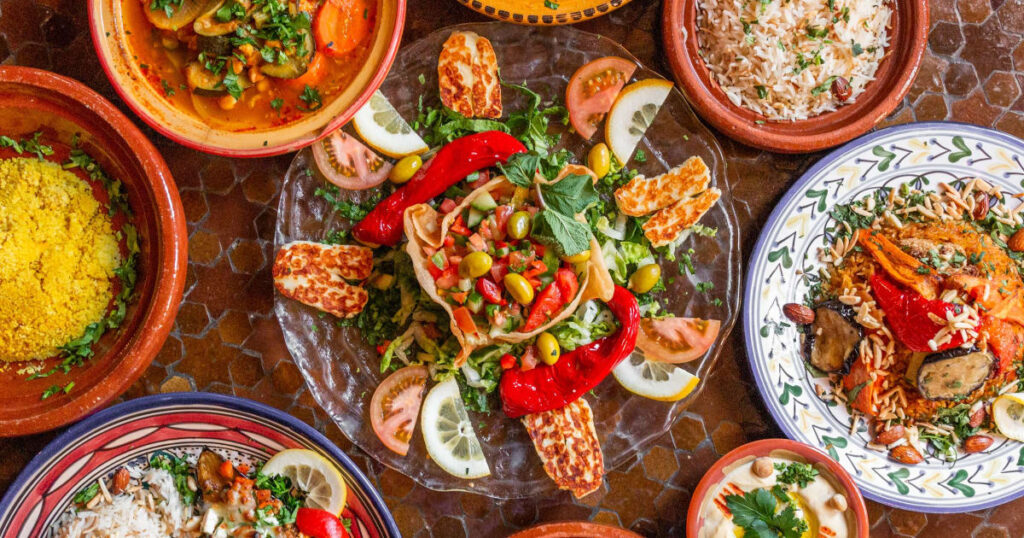Top 16 Traditional Persian Food Culinary Delights

Top 16 Traditional Persian Food Culinary Delights Embarking on a literary journey through the rich tapestry of Persian culture, one finds themselves in the enchanting realm of Iran, a land steeped in history and tradition. The mosaic of its culinary landscape mirrors the diversity of its people, each dish narrating a unique story and offering a delectable experience. Undoubtedly, much has been said and heard about the awe-inspiring landscapes and natural wonders of Iran. Equally captivating are the historical sites, integral to any Iranian expedition. For further exploration, please refer to the provided address. Let us now delve into the fascinating world of Iranian gastronomy, a realm as diverse as the cultures it encompasses. Persian cuisine, like the varied ethnicities that coexist within the country’s borders, is an intricate tapestry woven with nature’s bounty and cultural nuances. Rest assured, Persian cuisine has been put to the test and emerged victorious, as attested by countless foreign visitors who extol the virtues of its flavors, aromas, freshness, and culinary finesse. Each day in Iran promises a culinary adventure, a chance to tantalize the taste buds and immerse oneself in the richness of Persian culture. Savor the allure of Persian Food, a culinary masterpiece that transcends mere meals, inviting you to experience the essence of Iran’s cultural diversity. Let the tantalizing aromas and exquisite flavors of Persian Food transport you to the heart of Iran, where culinary artistry meets cultural celebration. The Pinnacle of Persian Food Palate: The 5 Exquisite Iranian Dishes Zereshk Polo An exemplary Iranian dish, frequently gracing important gatherings, is Zereshk Polo, often paired with succulent chicken. Crafted from the harmonious blend of barberry (Zereshk), saffron, and white rice, this dish not only delights the palate but also captivates with its visually stunning presentation. Zereshk Polo with chicken stands as a testament to Iran’s culinary prowess, garnering global acclaim for its surprising ease of preparation. Savor the exquisite blend of barberries, saffron rice, and tender chicken in Zereshk Polo – a culinary masterpiece that promises a journey of flavors like no other. Khoresht-e Ghormeh Sabzi A favorite among Iranians, Ghormeh Sabzi stew boasts a medley of aromatic vegetables, onions, Omani lemon, and a choice of red beans, sheep, veal, or lamb meat. The stew’s culinary magic lies in the extended cooking time, a characteristic shared with many Iranian dishes. Savored with plain or saffron-infused rice, Ghormeh Sabzi promises a flavorful and captivating experience for international connoisseurs. Indulge in the aromatic symphony of Ghormeh Sabzi, a Persian delight brimming with succulent meats and a dance of flavorful herbs, a true culinary enchantment. Khoresht-e Fesenjan Fesenjan stew, a Persian food that reigns supreme at significant gatherings and celebrations, is a gastronomic masterpiece. Crafted from ground walnuts, pomegranate paste, and chicken or meatballs, this stew hails from the northern regions of Iran, originally prepared with duck. While the cooking process demands patience at a low heat, mastering the technique ensures a home-cooked rendition as delightful as the authentic dish. Variations across Iran introduce subtle nuances, with some regions favoring a sour note by increasing the pomegranate syrup or adding a touch of sugar for sweetness. Chelo Kabab Koobideh Undoubtedly the most renowned Iranian dish or you say fantastic Persian food, Chelo Kabab (Kebab served with rice) has become synonymous with Iranian culinary expertise. Various kebabs, particularly Koobideh, enjoy immense popularity among locals and tourists alike. Koobideh, a ground meat blend seasoned with minced onion, salt, and pepper, takes center stage. Accompanied by grilled tomatoes and peppers, saffron rice, Dough (a yogurt-based drink), and fresh vegetables, this culinary masterpiece showcases the depth of Iranian gastronomy. Notably, Iranians occasionally opt for Kubideh with bread in lieu of rice. Persian Chicken Kebabs or Jujeh Kebab In a meat-loving culture, Iranian culinary traditions celebrate the preparation of grilled chicken, or Jujeh Kebab, a delectable dish enjoyed amid nature’s embrace. A pre-grilling ritual involves marinating chicken pieces in a mixture of grated onion, salt, and saffron, enhancing the dish’s flavors. Served alongside grilled tomatoes, saffron rice, and butter, this combination promises a mouthwatering experience. In the world of cuisine, Persian Food stands as a vibrant palette of flavors, offering a sensory voyage into the soul of Iran’s diverse culinary landscape. Beyond the Culinary Crown Jewels: Other Gastronomic Wonders in Iran Kuku Sabzi Kuku Sabzi, a versatile dish often served for dinner or as a snack, stands out for its simplicity and ease of preparation. Varieties abound across cities, with each locality infusing its distinctive touch. Comprising eggs and aromatic vegetables, Kuku Sabzi’s taste profile is elevated with the addition of chopped walnuts, barberries, or even beans. Beryani Isfahan’s renowned Beryani, a dish transcending regional boundaries due to its delightful taste, traditionally features mutton meat. Modern adaptations include chicken as a viable alternative. The dish, rich in history, incorporates sheep meat, onions, sheep lung, oil, turmeric, salt, and pepper, adorned with walnuts and basil. Served with vegetables, lime, and bread, Beryani represents a culinary journey through time. Khoresh Bademjan Eggplant lovers rejoice in the delightful Khoresh Bademjan, a savory stew combining meat, onions, spices, fried eggplants, and a generous portion of sour grapes. Typically presented with white or saffron-infused rice, this dish pays homage to Iranians’ affinity for eggplant. Dolmeh Dolmeh, encompassing various types such as grape leaf dolma (Dolmeh Barg Mo), tomato dolma, eggplant, and bell pepper, has permeated Iranian cuisine, transcending its regional origins in West and East Azerbaijan. Featuring a filling of ground meat, dolma vegetables, onions, and split beans, it stands as a testament to culinary diversity. Kale Pache A traditional dish prevalent in the Middle East and South Caucasus, Kale Pache captivates with its enduring popularity. A high-energy, fatty dish, it requires skilled preparation and is typically consumed in the morning. Caution is advised for those with specific health concerns, given its elevated fat content. Mosama Khoresht Alu (plum) Mosama stew, a popular Persian Food delight, showcases regional variations in its preparation. Chicken stew with plum
